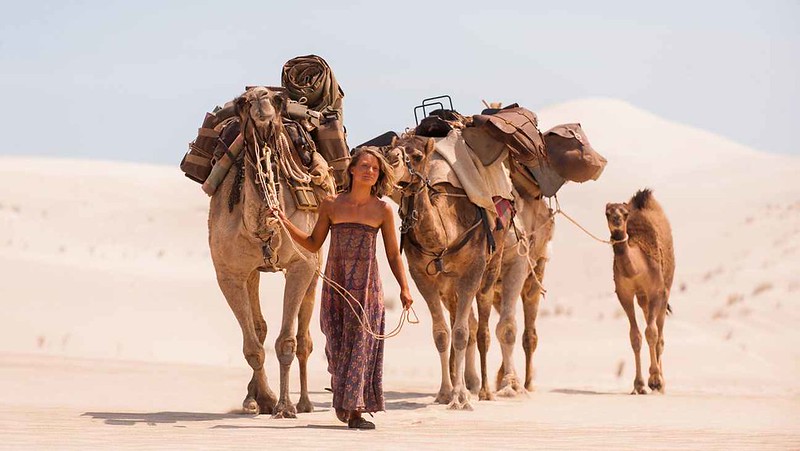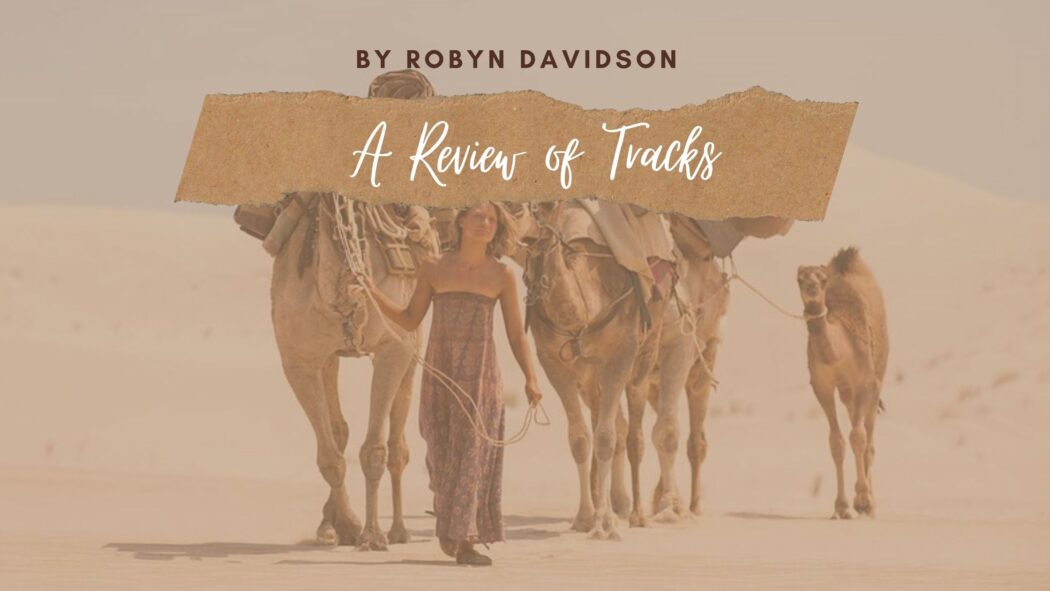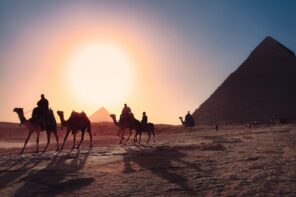Have you ever thought about doing something so outlandish and inconceivable that it may actually work?
This is exactly what Robyn Davidson did when she decided to embark on a trip across the Australian desert in 1977. It may not sound at all remarkable but when you think that, at this time, there was no GPS digital tracking system available, Google maps didn’t exist and mobile telephones were not widely used, this was hugely ambition.
“When I set out it was still just possible to travel through that country as a free agent,
to stay beneath any kind of radar, to take full responsibility for your own life.”
On top of that, because she was a female it was perceived that she was less likely to succeed in her adventure then a male. A somewhat sexist thought but I have to wonder whether it would still be the opinion of many today. Has society progressed far enough to see that women can accomplish as much as men can, even when it comes to adventure travel.
The Story of Robyn Davidson
“There are some moments in life that are like pivots around which your existence
turns – small intuitive flashes, when you know you have done something correct for
a change, when you think you are on the right track.”
More than 30 years ago, Robyn and her dog Diggity set off from Adelaide and spent two days crossing the country, taking in over 500 miles to reach Alice Springs. Her aim was simple.
“The lunatic idea was, basically, to get myself the requisite number of wild camels
from the bush and train them to carry my gear, then walk into and about the
central desert area.”
Robyn’s aim was clear, she wanted to do something different but her plan was rudimentary and limited in depth. Of course this would change in time; after all, her stay in Alice Springs would be longer than even she anticipated at the start. What’s more, what started as a physical challenge also turns into one of self development and internal reflection.
As soon as she arrives she strives to find work with those that know camels best. To begin with she was told that Sallay Mahomet knew exactly what to do and was an expert at camel rearing but when she approached him he refused to help. In fact, only one person would agree to help and not necessarily because they believed she would succeed but more because she was cheap labour.
Kurt was a ruthless, unforgiving, tiresome and sexist man who was rude and obtuse with everyone including Gladdy his poor wife and their camels. He hated tourists even though he needed them to survive and wasn’t particularly kind to either Robyn or the camels. In fact, he was the epitome of everything she came to associate with the town.
“It is a frontier town, characterized by aggressive masculine ethic and severe racial tensions.”
Her perseverance however did eventually pay off and over the time spent with Kurt and Gladdy her instincts to work alongside the camels increases until she can work intuitively with them. She learns how to care for them, control them when necessary and read what their needs are by observing and working with them for hours each day.
It did however, take time. Time that I am not sure even Robyn anticipated when she set off from the comforts of Adelaide and I have no doubt that her experiences during this period strengthened her resilience and opened her eyes to the vastly different opinions of those around her.
“Had everyone been trying to put the fear of god into me just because I was an
urbanite in the bush? Had I suddenly landed in Ku Klux Klan country?”
Robyn was quick to realise that the life she had previously lived was quite sheltered in comparison to those that had be exposed to a more rugged life in the outback. People didn’t necessarily appreciate her arrival, were quick to intimidate her and happy to share their racist thoughts openly with her. Perhaps the most disturbing however, were the thoughts that people were willing to share about the local Aboriginal people. They would comment on their way of life, their beliefs and how they saw them as insignificant even though if they were to look back on the history of their country they would see that they were in fact intruding on the land belonging to Aboriginal natives.

Robyn and her camels. Image provided by Viaggio Routard
Undeterred by their comments, Robyn was determined to achieve her goal of walking more than 2000km across the desert with only camels for company. She was sick of moving from one job to another and felt vaguely bored with life therefore, this was a challenge that she felt she needed to succeed at.
“…sick of carrying around the self-indulgent negativity which was so much the
malaise of my generation, my sex and my class.”
It was this determination that ultimately saw her wander into the desert alone, supported by her camels Zeleika, Dookie, Bub and baby Goliath.
However, where she had seen her experience unfolding in a solo, very personal way, short of funds she was advised to reach out to the publication National Geographic, to see whether they would be interested in providing coverage of her expedition, which of course they snapped up, leading her to feel disgruntled, resentful and frustrated that her individual adventure was being invaded by others.
“I was again overcome by a sense of failure. Not just of the trip but a kind of
personal failure – the absolute impossibility of ever winning against brute
force and domination.”
That first day when she walked away from others though lead to her feeling something rather different:
“All I remember of that first day alone was a feeling of release; a sustained,
buoyant confidence as I strolled along.”
While that sense of peaceful contemplation and success may not continue to stay with her throughout her journey across the desert, nothing can take away from what she achieved or the appreciation that grew for the Aboriginal people and the depth of her own self discovery.

My Thoughts on Tracks
“Reaction to what I was doing was so unexpected. “I was now public property.
I was now a feminist symbol. I was now an object of ridicule for small-minded sexists,
and I was a crazy, irresponsible adventurer (though not as crazy as I would have
been had I failed). But worse than all that, I was now a mythical being who had done
something courageous and outside the possibilities that ordinary people could hope for.”
Reading about the bravery, and I do see it as extremely brave, of one woman more than 30 years ago gives me pause for thought. Could I do something similar? Would I want to?
Robyn Davidson may have felt frustrated that her trip changed when National Geographic got involved, but for those of us that are reading about her achievement from the comfort of our own armchair I only see an extremely courageous woman striving to achieve something that no-one else has ever achieved and while she sees herself as an ordinary person, I personally see her as extraordinary.
For women looking for strong role models, Robyn Davidson embodies everything we should be aspiring towards. She is a fiery, independent woman, ahead of the curve and unwilling to compromise because she is female. Tracks is therefore a story of female empowerment and something that we should be celebrating more. It may be a 30-year old story but I don’t believe that it is at all out of touch with the fight we still have for equality and independence today. Not only that, it is also highlights that Australian society was far more sexist than the Aboriginal community and perhaps remain so even now.
“…made me realize that, contrary to what most white male anthropologists would
have us believe, women hold a very strong position in Aboriginal society. While men
and women have separate roles, necessitated by environment, these roles are part of
a single function – to survive – and both are mutually respected. With their dexterous
food-gathering, the women play a greater part in feeding the tribe than do the men, whose
hunting might only bring in the occasional kangaroo.”
Therefore it is also an educational read, highlighting the continual struggles of the native Aboriginal population and the fights that they face every single day to be seen as equal to others than now inhabit their land.
“Thought about how they’d been slaughtered, almost wiped out, forced to live
on settlements that were more like concentration camps, then poked, prodded,
measured and taped, had photos of their sacred business printed in colour in heavy
academic anthropological texts, had their scared secret objects stolen and taken to
museums, had their potency and integrity drained from them at every opportunity, had
been reviled and misunderstood by almost every white in the country, and then
finally left to rot with their cheap booze and our diseases…”
Whether you are looking to read this for the first time, or re-read this story, I am sure many of the themes exposed during this tale will resonant with you even now. While I believe we had made progress and now see feminism and value the Aboriginal community and their values far more than people once would, we still have further to go on this journey towards equality to all.
Even without the strength of these threads that run through the narrative, the simple story of one woman against the cruel and deadly desert is one of extraordinary resilience and highlights that often it is sheer determination that leads to success.
Looking for more books to read before your trip to Australia? Want to learn more about the history of this fascinating country? If the answer is yes, we have the perfect article for you. 11 top books to read on Australia highlights the best books to be reading right now if you want to learn more about the country.
Disclaimer: Some links in this article are affiliate links, which means that if you purchase through them, we receive a small commission.
If you are based within the UK or the US and prefer to support independent bookshops, then you can find a full list of all the books and authors mentioned in this article on our bookshop page.
Did you enjoy this article? Then PIN it for later…







